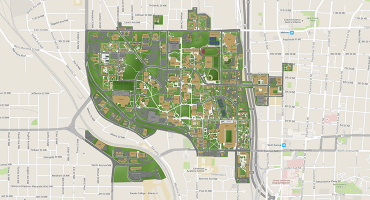To request a media interview, please reach out to School of Biological Sciences experts using our faculty directory, or contact Jess Hunt-Ralston, College of Sciences communications director. A list of faculty experts and research areas across the College of Sciences at Georgia Tech is also available to journalists upon request.
In an article published by The Conversation, Benjamin Freeman, assistant professor in the School of Biological Sciences, discusses his research, including a recent study on how mountain birds in the Pacific Northwest are responding to climate change.
The Conversation | 2025-11-27T00:00:00-05:00
A team of researchers from the School of Biological Sciences published a paper on interlimb training and how it may provide tangible benefits during early-stage rehabilitation following upper limb amputation, especially in cases of partial-hand loss.
Nature Scientific Reports | 2025-11-05T00:00:00-05:00
Scientists have long thought that a lizard losing a leg should be a death sentence. New evidence seems to overturn this assumption, showing that some lizards can not only survive, but even thrive after losing one or more limbs.James Stroud, an evolutionary biologist at the Georgia Institute of Technology, has spent years catching lizards in the wild to study how they evolve. He and his colleagues long thought that even the smallest difference in the length of a lizard’s leg could affect its ability to run from predators and chase their prey. Losing an entire limb seemed much more severe.However, every now and then he and his colleagues would observe something odd. “We’ll find a lizard completely missing its leg, and it seems fine,” Dr. Stroud said. He casually calls them “three-legged pirate lizards.”
The New York Times | 2025-10-21T00:00:00-04:00
James T. Stroud, assistant professor in the School of Biological Sciences, coauthored an article published in The Conversation detailing research which documents exceptional cases of lizards — survivors of limb damage or loss — that defy expectations about how natural selection works.
The Conversation | 2025-10-13T00:00:00-04:00
Last Friday, the Spatial Ecology and Paleontology Lab (SEPL), led by School of Biological Sciences Associate Professor Jenny McGuire, hosted its weekly Fossil Friday event. This hands-on outreach program invites participants to uncover ancient history, explore real fossils, and learn about the discoveries made by scientists beneath the approximately 80-foot drop of Natural Trap Cave in Wyoming.The goal of Fossil Friday is straightforward: to build a community centered on science outreach and enable people to interact directly with fossils. The event is open to students, faculty, and Atlanta locals alike, offering a relaxed space to learn, discover, and have fun.
Technique | 2025-10-03T00:00:00-04:00
As autumn begins, Georgia skies become a busy highway for millions of migrating birds, heading south. Benjamin Freeman, a biologist at the Georgia Tech School of Biological Sciences, says the timeline for this fall migration period is just beginning here in the Peach State. Watch the 11 Alive interview featuring Professor Freeman.
11 Alive | 2025-09-15T00:00:00-04:00
School of Biological Sciences Professor Marvin Whiteley has been named the 2026 recipient of the American Society for Microbiology's D.C. White Award for Interdisciplinary Research. This award recognizes Whiteley’s distinguished accomplishments in interdisciplinary research and mentoring in microbiology.
American Society for Microbiology | 2025-09-05T00:00:00-04:00
Reproduction is strange in many social insects, but the Iberian harvester ant (Messor ibericus) takes the weirdness to the next level. Queens mate with males of another species and then clone them, researchers report today in Nature, which means this ant is the only known organism that propagates two species by itself. Evolutionary biologist Jonathan Romiguier of the University of Montpellier, who led the team, calls M. ibericus “in a sense, the most complex, colonial life form we know of so far.”The finding “is almost impossible to believe and pushes our understanding of evolutionary biology,” says Michael Goodisman, an evolutionary biologist and professor in the School of Biological Sciences at the Georgia Institute of Technology who was not involved with the new research. “Just when you think you’ve seen it all, social insects reveal another surprise."
Science Magazine | 2025-09-03T00:00:00-04:00
A team of researchers from the School of Biological Sciences found some answers to the mystery of gene regulation by turning to the trusty roundworm C. elegans, a frequently studied model organism that has contributed to many important discoveries. In their new study published in GENETICS, the researchers used a powerful new approach to compare gene activity across several types of wildly diverse worm strains from all over the world to uncover their regulatory structure.In this first of its kind study, the researchers crossed each strain of worm with their standard N2 lab strain to make a hybrid offspring. They then used a modern and powerful technique called allele-specific RNA sequencing to determine how the genes were being used in these new strains, and which parent DNA is driving the gene’s activity.
Genes to Genomes | 2025-08-15T00:00:00-04:00
Researchers at the Georgia Institute of Technology and India's National Center for Biological Sciences have found that yeast clusters, when grown beyond a certain size, spontaneously generate fluid flows powerful enough to ferry nutrients deep into their interior.In the study, "Metabolically driven flows enable exponential growth in macroscopic multicellular yeast," published in Science Advances, the research team — which included Georgia Tech Ph.D. scholar Emma Bingham, Research Scientist G. Ozan Bozdag, Associate Professor William C. Ratcliff, and Associate Professor Peter Yunker — used experimental evolution to determine whether non-genetic physical processes can enable nutrient transport in multicellular yeast lacking evolved transport adaptations.A similar story also appeared at The Hindu.
Phys.org | 2025-06-24T00:00:00-04:00


